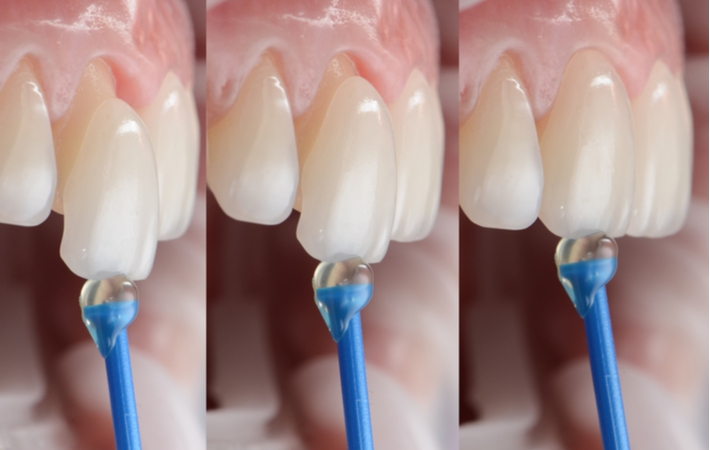Replacing a Missing Tooth
A missing tooth can impact your dental health and the appearance of your teeth. Although a knocked-out tooth is a dental emergency, an extracted tooth still requires attention. Missing or damaged teeth can be replaced or repaired with restorative dentistry.
Restorative dentistry uses fillings, crowns, bridges, and more to provide structure or function to support your oral health. But there can also be some crossover with cosmetic dentistry. Restoring teeth can also adjust the look of your teeth, boosting your smile confidence.
When a tooth is missing, it may be an opportunity to enhance your smile. For example, if the old tooth was discoloured or crooked, you might consider veneers. But can veneers replace a missing tooth?
What are Veneers?
Veneers are a cosmetic dental treatment. The thin, tooth-coloured shells attach to the front surface of teeth to alter shape or colour. Veneers are made using porcelain or composite resin. Both types of veneers are permanent.
Porcelain veneers are more durable and longer-lasting, generally over a decade. Additionally, porcelain resists staining or discolouration better than composite resin. Applying porcelain veneers typically takes 2 visits.
Although composite resin veneers are less durable than porcelain, they can be easier to repair. Placing composite resin veneers typically takes one visit, as less enamel is removed during the procedure.
Veneers can benefit the appearance of teeth by treating:
- Broken or chipped teeth
- Teeth with severe discoloration
- Gaps in the teeth
- Uneven or too-small teeth
- Irregularly shaped or pointed teeth
As veneers are custom-fitted, placing veneers requires technical skill and an eye for detail. Veneers need to look beautiful and function appropriately.
Fitting Your Veneers
During your first appointment, the original tooth is shaped, and a thin layer of enamel is removed. Then a mould is made, and a colour is selected. Next, temporary veneers are placed while the custom veneers are created using the mould.
At the second appointment, the dentist uses a mild chemical to roughen the tooth surface, helping the veneers to stick better. Then, the permanent veneers are carefully placed and glued to each tooth using composite resin cement.
Your dentist will also schedule a follow-up appointment to evaluate how the veneers function and how comfortable you are with your new smile.

Can Veneers Replace Missing Teeth?
Unfortunately, veneers cannot replace a missing or extracted tooth. As veneers are attached directly to your teeth, a healthy structure is necessary. The presence of unhealthy tissue, even if the tooth is still attached, can also make patients poor candidates for veneers.
You may not be an ideal candidate if:
- There is too little enamel left
- Too much of the tooth is missing
- You grind or clench your teeth (bruxism)
- You have tooth decay
- You have untreated gum disease
Gum disease and tooth decay are preventable and can be treated when detected early. After successfully treating gum disease or tooth decay, your dentist can reassess if you’re a good candidate for veneers.
Veneers After Dental Implants
Although veneers cannot replace a missing tooth alone, you can attach veneers after a dental implant procedure. Veneers require a sturdy surface to adhere to, but an artificial or replacement tooth can be equally suitable.
It is possible to attach a single veneer, but most patients choose 6–8 veneers to create an even appearance. It’s most common to select the teeth most prominent when you smile. When a missing tooth interrupts your complete set, a dental implant can help patients achieve a symmetrical smile.
What are Dental Implants?
A dental implant is an artificial root made of titanium. The implant is surgically inserted in the jaw bone, an anchor for a replacement tooth. Placing a dental implant typically takes 2 visits. Then, the tissue heals, allowing the implant to bond with the jaw bone and attach to the gum. Recovery can take several months.
The steps of the dental implant process are:
- Inserting the implant beneath the gum line
- Stitching the gums back into place
- Recovery (the implant bonds to the bone & gums)
- Attaching the abutment (a small post) to the implant
- Fitting and attaching the artificial tooth
Who Is a Candidate for a Dental Implant?
Dental implant procedures have a success rate of 98%. When cared for consistently, dental implants can last a lifetime. However, it’s crucial to have healthy gums and enough bone to support a dental implant.
Your dentist can assess if you’re a good candidate after a dental exam. For example, patients with gum disease are not good candidates, as the disease breaks down the gum and bone that holds teeth in place. However, if detected early, your dentist can work with you to treat gum disease. Then, if treatment is successful, you may be a good candidate for a dental implant.
Call Us to Replace a Missing Tooth
Whether you have a missing tooth or are concerned about damaged teeth, Van Mills Dental in Mississauga can help. We want our patients to feel confident about their smiles and oral health. Dr. Demarchi can determine if you’re a good candidate for veneers or recommend more options to improve the function and appearance of your teeth. Contact us today!


